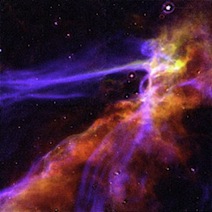Back in 1998, two teams of astronomers carried out observations on a particular kind of stars, type Ia supernovae. They had no idea their results were going to completely change the way we see our Universe.
Supernovae Ia are often referred to as ‘standard candles’, because they all achieve the same luminosity before exploding. Thus their distance can be measured using their apparent brightness. As the light emitted has been redshifted by the expansion of the Universe (the expansion of space stretches light into longer and longer waves; the longer the wavelength, the redder the light), we can determine how much the Universe has expanded since the supernovae occurred.
The expansion of the Universe
At that time, everyone agreed on the fact that the expansion of the Universe (coming from the energy of the Big Bang) had to be slowing down, because of gravity pulling all matter together. If so, then the supernovae the teams were observing would be brighter than their redshifts would indicate. When analysing their data, the astronomers actually observed the opposite phenomenon! This left only one possible explanation: the expansion of the Universe was actually accelerating.
As previously mentioned in the article The shape of the Universe, the cosmic microwave background analysis showed that our Universe is flat; according to the observations, there is not enough matter in the Universe to account for its flatness. The only possible conclusion was that some unknown form of energy with a strong negative pressure (in other words, acting repulsively) is causing the acceleration of the expansion of the Universe. Astrophysicists called it dark energy.
What is dark energy ?
The answer to this question is pretty simple: we don’t know. We only know how it affects the expansion of the Universe, and that it repesents about 70% of our Universe: most of our Universe is actually a complete mystery to us…
There are a few possible explanations for what dark energy could be. Some cosmologists identify dark energy with Einstein’s cosmological constant. Originally, Einstein introduced this constant in his theory of general relativity so that the Universe would remain static, according to his belief (without this constant, its theory predicted an expanding universe). When a few years later, Edwin Hubble showed that the Universe was expanding, Einstein finally discarded this cosmological constant, calling it his ‘biggest blunder’. This is a bit ironic that cosmologists later re-introduced it, to actually account for the acceleration of the expansion! In this case, dark energy would be a property of space: empty space has its own energy. Although this might sound a nice explanation, nobody knows either why this cosmological constant should be there, or why it should have just the right value to cause the observed acceleration.
Another attempt to explain the nature of dark energy is what we call ‘quintessence’. It would be a new form of dynamical energy fluid or field filling all of space. Its main distinguishing feature is a repulsive effect, in opposition to matter and ‘normal’ energy. Unfortunately, we have no idea why it should exist, what it should interact with, or what it is like…
Another possible explanation is that Einstein’s theory is not correct. Then, no new kind of energy or cosmological constant would be required. However a new theory of gravity would have to describe the motion of celestial bodies as well as Einstein’s does, and account for the acceleration of the expansion at the same time. So far, none of the propositions turned out to be satisfactory.
Today, most of our Universe remains completely unknown, and dark energy has been a conundrum for the past decade. We will need more and more observations and data to be able (or not…) to explain what today is the biggest mystery encountered by cosmologists.


